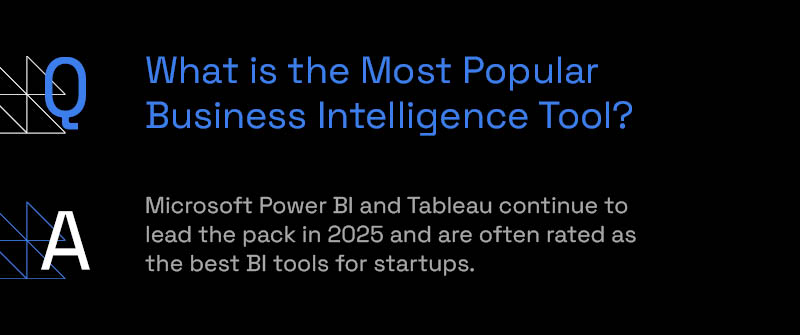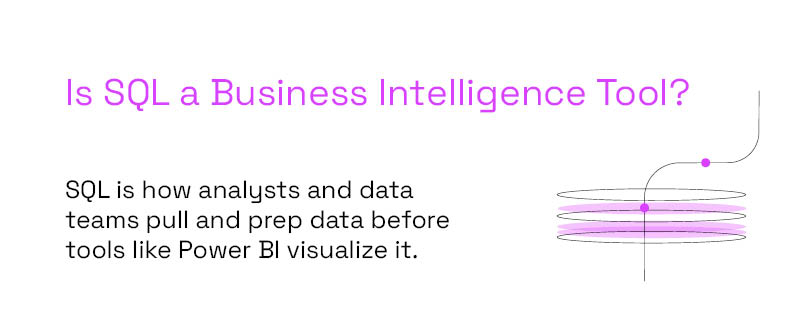
We get it, there are a lot of options for business intelligence tools out there. It can be difficult knowing which one is the right fit for your company’s business data and ongoing data discovery efforts. What works for a fast-growing startup might fall flat for a big enterprise with more complex data.
If you feel overwhelmed by the search for the best business intelligence (BI) tool, you’re not alone. Some platforms are user-friendly with drag-and-drop simplicity but may lack the depth your team needs. Others are more powerful under the hood but come with a steep learning curve. You may also have limited data preparation pipelines or need deeper data analysis capabilities. How do you find the right balance for your data, your team’s skill level, and your budget?
That’s where Power BI consulting can save the day. A good consultant will help to identify tools to fit your business goals and help avoid costly trial and error. They’ll translate raw numbers into actionable insights and design the data integration architecture that keeps everything flowing. Here, we’ll break down the top business intelligence tools to know in 2025 and how a BI consultant can help you to choose the best fit and get the most out of it.
What Are Business Intelligence and Tools?
Business Intelligence tools and strategies turn raw data into useful insights. Companies gather tons of data (think sales, marketing, finance, or operations, for example). With the help of a consultant, BI helps you visualize and analyze that data, transforming it into interactive dashboards, charts, and reports that surface key business metrics and enable quick data exploration. Instead of digging through spreadsheets or making educated guesses, business intelligence gives you fast, clear insights so you can make data‑driven decisions.
To Make That Happen, You Need the Right Tools
The business‑intelligence tools list has a wide range designed to help you gather, visualize, and explore data. Microsoft Power BI, Tableau, and Qlik are the heavy hitters in the space, and all three boast modern embedded analytics capabilities. A good consultant will come in and connect your data sources and make it easier to build clear, visual reports and dashboards to explore your data. Dundas BI and Sisense offer similar features. Microsoft Copilot is the newer kid on the block, adding AI assistance to speed things up. The best tool depends on your team’s skill set, your data complexity, and your business needs. A BI consultant can help you zero in on the right one.
Behind the Scenes: Data Mining Matters
Data mining is the engine that helps BI go deeper. It uses algorithms to look for patterns and trends that aren’t obvious at first glance. In business intelligence, data mining plays a key role in turning raw data into insights that help you make business decisions.It works behind the scenes so your data analysts receive timely data insights and can analyze data without friction. Think of it as creating a blueprint before building out your dashboards. A consultant can help you set up data mining the right way so you’re getting the information you need to stay competitive.
A real-world example? E-commerce platforms use data mining to suggest products based on your shopping habits and those of similar users. Amazon nails this with their “people who viewed this also like…” feature. That’s data mining driving both smarter shopping and better sales. Learn more about data mining types, benefits, and use cases in this article by Mailchimp.
All This Adds Up to Strategic Value
When BI is done well, it’s not just about pretty charts or cool dashboards—it’s about real business value. It helps you spot opportunities, reduce risks,improve operations, and power predictive analytics that uncover new revenue streams. BI empowers your teams with confidence since they’re making decisions based on facts, not gut feelings. Spoiler alert: To use business intelligence to maximize business outcomes and gain strategic value, having an expert in your corner makes all the difference.
P3 Adaptive’s expert BI consultants help you do just that. They’ll help guide you on how to get the most value from your data by building out reports, setting up dashboards, and empowering your team to use them day to day.
What is the Most Popular Business Intelligence Tool?
Microsoft Power BI and Tableau continue to lead the pack in 2025 and are often rated as the best BI tools for startups. Other major players on the business intelligence tools list include Qlik Sense, SAP BusinessObjects, Domo, and Looker Studio. Power BI remains a top dog for good reason; it’s flexible, easy to use, and integrates seamlessly with other Microsoft tools (hello, Excel and Azure lovers). From building simple dashboards to diving into advanced analytics, Power BI is a great choice. A consultant can tailor it to your needs and help you get the most out of it, showing you why Power BI is the go-to for many businesses.

Power BI + Microsoft Fabric: A Powerful Pair
Haven’t heard of Fabric? It’s Microsoft’s all-in-one data platform that brings together everything from data engineering to real-time analytics under one roof. Fabric is built to streamline the entire data journey (from data gathering to transformation to easy-to-view insights for better decision-making). Partner with a Microsoft Fabric consultant to combine Fabric with Power BI, and you’ve got a dynamic duo. Together, they create a unified experience that simplifies the entire data process. No more switching between tools. For companies looking to centralize their data and speed up insights, this combo is a power move.
Why Does This Matter for Your Business Goals?
When your data tools are connected and easier to use, your team moves faster and with more confidence (less time wrangling reports = more time acting on insights). Maybe you’re trying to improve customer experiences, optimize operations, or spot growth opportunities. Whatever your goals, Power BI + Fabric can be a serious advantage.
Again, having the right support matters. A consultant can help you choose the right tools from the top business intelligence companies, configure them for your business, set up reporting and analytics, plus get your team up to speed. P3 Adaptive’s impact forward approach empowers you to leverage Power BI with your current systems; you’ll get value right away vs. overhauling your entire system like traditional consultants.
What Are the Top Five Most Used Business Analytics Tools?
The top five analytics tools for 2025? Tableau, Power BI, SAS, KNIME, and Apache Spark. Of course, there are plenty of other options out there as business analytics has become essential to stay ahead. Each tool has its own strengths; some are great for deep analysis, while others shine in real-time dashboards. Analytics tools are crucial to business success, so choosing the right one is key.
Here’s a closer look at the top five BI tools in 2025—and what makes them stand out:
- Power BI – Microsoft’s powerhouse BI tool is a top choice for many teams thanks to its intuitive interface, flexible data modeling, and seamless integration with Excel and other Microsoft products. It’s especially useful for companies already in the Microsoft ecosystem and offers both self-service and advanced analytics capabilities.
- Tableau – Known for its stunning visualizations, Tableau shines when it comes to turning complex data into interactive, easy-to-understand dashboards. It’s ideal for data storytelling and suits organizations with a strong focus on visual data exploration and insight presentation.
- Qlik Sense – Qlik’s associative engine allows users to freely explore data without being restricted to predefined query paths. It’s strong on real-time analytics and excels in environments where fast, flexible analysis is key. It also offers robust security and governance features.
- SAS Business Intelligence – Built for deep analytics, SAS BI is a favorite in industries like healthcare and finance where statistical rigor and data governance matter. Its strength lies in its predictive analytics and advanced data science capabilities, though it tends to require more technical expertise.
- KNIME – An open-source favorite, KNIME (Konstanz Information Miner) is loved for its visual workflow interface and strong machine learning capabilities. It’s great for teams that need to blend data science with traditional BI workflows without heavy licensing costs.
Tools like Dundas BI and Sisense offer similar flexibility, especially for teams looking to embed BI into customer-facing apps or products. Meanwhile, Microsoft Copilot is a newer player that leverages AI to enhance data queries and insight generation—speeding up reporting without sacrificing depth.
The best tool depends on your team’s skill set, your data complexity, and your business needs. A BI consultant can help you zero in on the right one and ensure your setup is streamlined, future-proof, and aligned with your goals.
BI Tools and Analytics Tools: The Same Thing?
Not quite. They’re closely related, but not the same. BI tools help you understand what’s already happened (think performance, sales, or website traffic). Analytics tools take things a step further. They dig into the ‘why’ behind the numbers, looking for patterns and predicting what might happen next. That said, most modern platforms now blur the line between the two.
Choosing the Right Tool
Think about your company size, team’s tech comfort level, data complexity, and budget. Tools that are user-friendly and integrate well with your current systems tend to be adopted faster. This is another area where a consultant shines. They’ll help match you with the right tools, get everything set up properly, and make sure your team is ready to hit the ground running. A consultant can also train your team to ensure adoption—they‘ll feel empowered with new tools vs. feeling like a fish out of water.
Data Visualization: Where Things Are Getting Exciting
Data visualization is where a lot of the innovation is happening. Businesses now want interactive, real-time visuals that help them act fast. Things like dynamic graphs, voice-assisted queries, and even AI-generated summaries are making a big splash. Visuals are becoming smarter and more helpful (no need to look for answers in a sea of spreadsheets). A BI consultant can help you design visuals that bring your data to life.
Is SQL a Business Intelligence Tool?
Not exactly, but it’s a big part of the process. SQL (Structured Query Language) is how analysts and data teams pull and prep data before tools like Power BI visualize it into awesome reports and dashboards. SQL and BI tools serve different purposes, but they work closely together. SQL gets the data ready. BI tools bring it to life.

SQL is about writing code to control and fine-tune your data, perfect for slicing and dicing complex data sets. BI tools focus on the visuals. Most BI tools lean on SQL behind the scenes for the more complex stuff. So yes, knowing SQL gives you a big edge.
When you’re thinking about BI strategy, SQL should be part of your conversation. It might not be flashy like a cool dashboard, but it’s the foundation for meaningful analysis. And if you’re not sure how to bring it all together, a BI consultant can help you combine tools with a strong SQL base so your insights are fast, accurate, and relevant.
Conclusion
Yes, picking the right BI tool can feel a bit overwhelming. With lots of options and each one promising to be ‘the one’, how do you choose? Sure, cool dashboards are great, but the real magic happens when your tools, your data, and your teams are all working in sync. Plus, you also need to think about data analytics and how to use that to take BI even further.
Here’s where we come in. At P3 Adaptive, we help you figure out what you need (and what you don’t), what tools make the most sense for your business, and we’ll set it up for success. Our expert consultants are the best at developing custom solutions that get you what you need in weeks, not months. Contact us today—let’s do this.
Get in touch with a P3 team member